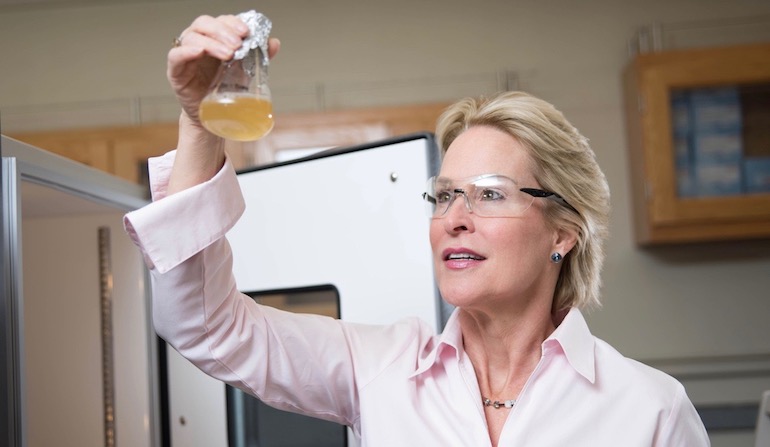 Intelligent Design
Intelligent Design
How the 2018 Nobel Laureates in Chemistry Harnessed Intelligent Design


I am an enzyme bioengineer, so I greeted with enthusiasm Wednesday’s announcement, noted here already by Doug Axe, that part of the 2018 Nobel Prize in Chemistry went to a fellow enzyme bioengineer. She is Frances H. Arnold, a professor of chemical engineering at Caltech.
Her accomplishments in the field are impressive, as is the work of her co-winners, whose work also involves bioengineering. The three are indeed deserving recipients.
There is one point of confusion in descriptions of this year’s prize winners. It’s the talk of “directed evolution.” The Nobel Prize organization itself has encouraged such talk. The official announcement is titled “They harnessed the power of evolution.” It continues:
The 2018 Nobel Laureates in Chemistry have taken control of evolution and used it for purposes that bring the greatest benefit to humankind. Enzymes produced through directed evolution are used to manufacture everything from biofuels to pharmaceuticals.
The New York Times goes on in the same vein:
At first, Dr. Arnold attempted “rational design,” employing logic and knowledge of how proteins function to try to build new enzymes — proteins that act as catalysts for chemical reactions. But enzymes are large, complicated molecules — some consisting of thousands of amino acids — and it is hard to figure out how a shift in one twist of the molecule affects how it works.
In desperation, she said, she turned to evolution.
“I copied nature’s inventions, this wonderful process of evolution, to breed molecules like you breed cats and dogs,” she said.
For this “directed evolution” research, she inserted the gene that produced the enzyme she wanted to study into fast-reproducing bacteria. With mutations of the gene, she could then examine how well variations of the enzyme worked. She chose the one that worked best and repeated the process — just like evolution chooses the survival of the fittest over succeeding generations.
Conflating Artificial and Natural Selection
What’s the problem? First there’s the conflation of artificial and natural selection. More fundamentally, the term “directed evolution” is a contradictio in adjecto, in the same way the term “wooden iron” is. It obscures the reality that the new enzymes were engineered via intelligent design. We’re called bioengineers for a reason, after all.
The role of the term “directed evolution” is contrasted with “rational design.” This second phrase is also a contradictio in adjecto. The placing of the adjective “rational” in front of “design” implies that design can be wholly non-rational, wholly separate from the work of creative intelligence, of mind. But that is contradictory to all generally accepted definitions of design.
The following excerpt from my essay in the recent anthology Theistic Evolution: A Scientific, Philosophical, and Theological Critique describes the random and designed aspects of the so-called “directed evolution” approach to bioengineering:
Enzymes are widely used for many different applications: in washing powders, food manufacturing, textile industry, animal feed, and chemical production etc. Unfortunately natural enzymes are not always suitable for industrial conditions where high temperatures, extremes of pH and variety of other chemicals interfere with enzymatic reactions. Using the tools of genetic engineering it is possible to modify existing enzymes with various methods. One approach is to randomly mutate the gene coding for a given enzyme. The process is called directed evolution (which is an oxymoron since it connects two opposing terms together). One then seeks to find better functioning mutants among the variants so created. Some amazing results have been achieved with this technique1:
- Enzyme activity has been improved.
- Thermal and pH stability has increased.
- Specificity has changed.
- Side activities have improved.
- Stability against solvents and oxidants has improved.
In spite of these achievements, the technique has its limitations:
- There must be a mutational pathway to the new structure.
- One must be able to create a large enough mutant library in order to find the rare positive mutants.
- One must have a rapid screening method to detect the rare positive mutants.
Hallmarks of Intelligent Design
In his book The Edge of Evolution biochemist Michael Behe draws upon research on E. coli, malaria, and HIV mutations. From this he calculates the upper limit for a random mutational process in nature at two to three simultaneous mutations in one protein. This is in harmony with Barry Hall’s results with lactase mutations.2
Bioengineers, including the 2018 Nobel laureates in Chemistry, are demonstrating a way beyond this limit — intelligent design. These brilliantly designed experiments involve mutation rates artificially engineered to occur at 10,000 to a million times the rate typical in nature, carefully selected reaction conditions, the intelligently selected use of genetic engineering tools (tools that are themselves intelligently designed), and the mindful selection of variants towards a desired goal.
All of these are hallmarks of intelligent design.
For more on the promising field of enzyme engineering, how it demonstrates the limits of natural evolutionary processes and the reach of intelligent design, see Chapter 10 of my recently co-authored book Heretic: One Scientist’s Journey from Darwin to Design.
Matti Leisola, DSc, is a bioengineer and former dean of Chemistry and Material Sciences at Helsinki University of Technology. An expert in enzymes and rare sugars, he has published 140 peer-reviewed articles and won the Latsis Prize-ETH Zürich. He also served as biotech research director for Cultor, an international biotech company, co-founded the International Society of Rare Sugars, and was the founding editor of BIO-Complexity.
Notes:
- Matti Leisola, and Ossi Turunen, “Protein Engineering: Opportunities and Challenges,” Applied Microbiology and Biotechnology 75 (2007): 1225-1232, doi:10.1007/s00253-007-0964-2.
- Barry Hall, “The EBG System of E. coli: Origin and Evolution of a Novel Beta-Galactosidase for the Metabolism of Lactose,” Genetica 118 (2003): 143-156.
Photo: France Arnold, via Caltech (press release).
